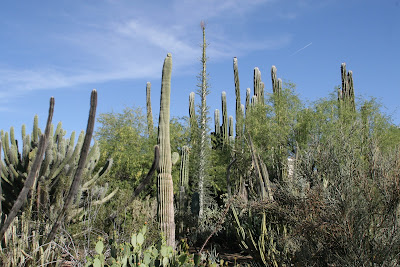For more than 70 years, the Desert Botanical Garden has been teaching and inspiring visitors from the local community and around the world, providing research, exhibits and more designed to help us understand, protect and preserve the desert’s natural beauty.
Today, the Garden features:
145 acres
65 acres under cultivation
50,000+ plant displays showcased in beautiful outdoor exhibits
1 of only 44 botanical gardens accredited by the American Association of Museums
1,140 volunteers
82,740 volunteer hours
104 staff members
640,529 attendees each year
26,065 member households
46,158 school children on guided field trips
The Garden’s vision is to be the premier center in the world for the display, study and understanding of desert plants and their environments. The Garden strives to be an indispensable resource in the Southwestern United States for helping individuals learn about Sonoran Desert Plants as well as desert plants of the world, so that they will conserve and protect the natural world for the benefit of future generations. Every element of the Garden will reflect excellence, beauty and inspiration to transform the visitor experience into one of discovery and meaning about deserts and desert plants
Back in the 1930s, a small group of passionate local citizens saw the need to conserve our beautiful desert environment. One was Swedish botanist Gustaf Starck, who found like-minded residents by posting a sign, “Save the desert,” with an arrow pointing to his home. In 1936, they formed the Arizona Cactus and Native Flora Society (ACNFS) to sponsor a botanical garden to encourage an understanding, appreciation and promotion of the uniqueness of the world’s deserts, particularly our Sonoran Desert.
Scorpionweed is a member of the waterleaf family. The plant grows to a height of about 18
inches and has bristly stems and hairy, dark green leaves which grow to 5 inches long.
corpionweed grows along roadsides and in desert flats and washes at elevations below 4000 feet.
Judvic Steel Jam Sculpture
Agave macroacantha (Black-spined Agave) - This is a very distinctive small to medium-sized Agave is native to barren rocky ground in the Mexican state of Oaxaca and near Tehuacan in Puebla. It forms dense clumps to nearly 2 feet tall by 5 feet wide comprised of 10 to 16 inch wide rosettes. The rosettes have narrow blue-gray leaves that are evenly spaced and radiate straight out from the center of the plant. The leaves have very straight margins with contrasting small dark brown teeth and an even darker 1 inch long terminal spine. When this plant begins to flower the center leaves take on an attractive reddish hue from where the dark red inflorescence begins to emerge though it has been reported that the age of the plant needs to be 15 years or better to flower.
Coryphantha Pycnacantha
Webster Auditorium
Hand Rail
The flowers of this platyopuntia from northern Arizona, the grizzly bear cactus (Opuntia erinacea; Family Cactaceae) possess betalain pigments, which produce the brilliant color of this and many other cacti. The armature are leaf spines, i.e., modified leaf primordia, formed on the highly modified buds (areoles) of the flattened stem (cladode).
( Cylindropuntia Ramosissima )
The stems are succulent and formed into smaller diameter, cylindrical joints. The tubercles are only slightly raised and are diamond shaped in outline. The structure appears to reinforce the the spines.
FRUIT:
Mature fruit is small, dry and bears many spines
( Cephalocereus senilis )
Is a species of cactus native to Guanajuato and Hidalgo in eastern Mexico. It is threatened in the wild, but widespread propagation and popularity in cultivation have reduced the demand on wild populations.
It is a tall columnar species with clusters of stems, growing to 5-15 m tall; the individual stems are usually unbranched, being unable to withstand the weight of side branches easily (Mauseth Research). The most striking feature is the long, white hairs it possesses, which serve to protect it from the sun. The coat of hair makes many plants appear almost snow-white (however, the hairs conceal numerous sharp yellow spines). It is in reference to the shaggy white coat that the popular name 'Old Man Cactus' developed. At the young stage the cactus has silvery-white hairs, which are later lost as the plant grows.
The flowers are red, yellow, or white, though it may not flower until 10-20 years old.
( Ferocactus herrerae )
The stems are globular to columnar, usually unbranched, and pleated, ranging from less than a foot (30 cm) tall in the smallest species to 6 to 12 feet (1.8-3.7 m). The central spines are the larger of two types and arise from the center of the areole; the principle central spine often has a different shape from that of all the other spines. Radial spines are smaller and arise from the margins of the areoles. The short, funnel-shaped flowers are very stiff and usually don't extend beyond the spiny armor. The thick rind of the fruit is moist in Ferocactus. The seeds are packed in a dry interior, not embedded in pulp.
Till Next Time!!








































































































3 comments:
what r those pink poppy flowers? they popped up in my front yard.
I don't know my flowers but may be A weed.
I once read a weed is a flower in disguise.
Post a Comment